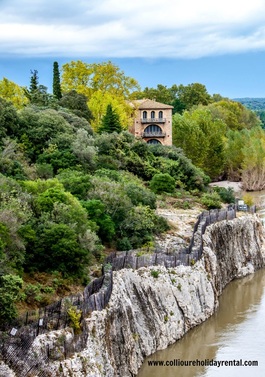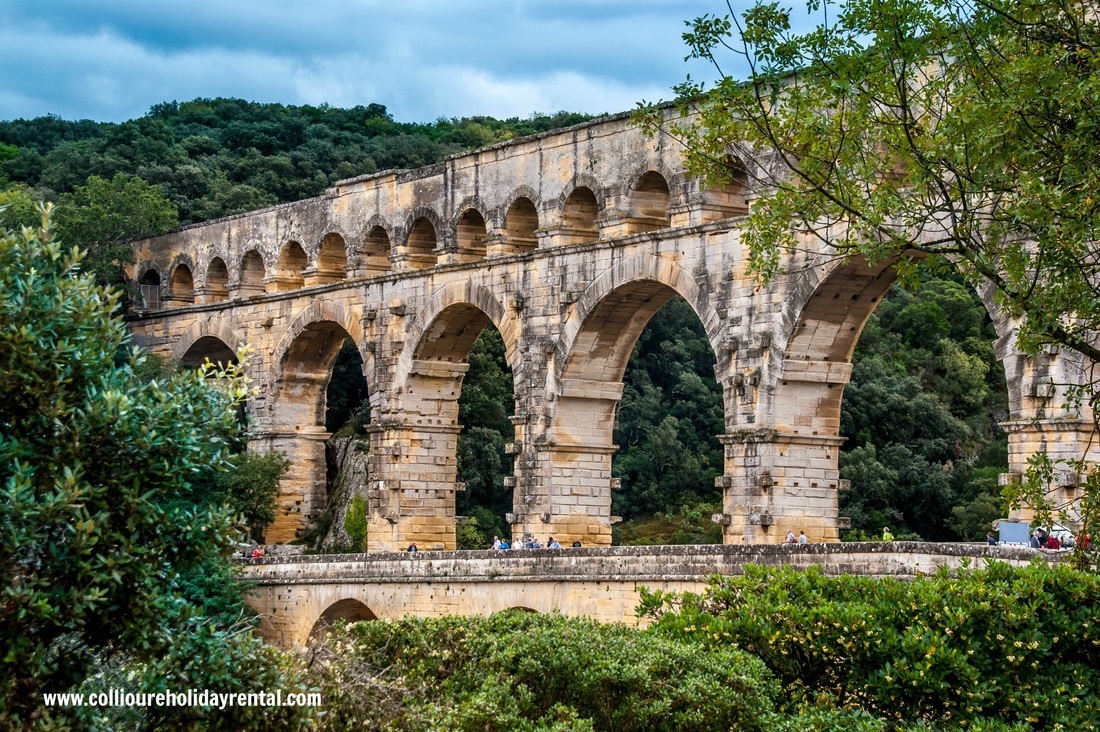
While visiting Collioure, you may decide you would like to do some sightseeing around the area. If you are interested in a slightly longer drive up the coast, perhaps 2 ½ hours, you can visit the Pont du Gard. We made an overnight trip to Uzès and stopped to see this magnificent structure on our way.
The Pont du Gard is a Roman Aqueduct bridge built in the 1st century. When you arrive to the location, you see only the ticket office and museum building. It is not until you travel the tree-lined path and you come out into a clearing when you see the enormous structure in front of you. It is truly awe inspiring to look at this impressive bridge that is so incredibly preserved.
The bridge is actually part of a much larger underground aqueduct system that spans more than 50 kms and was built by the Romans to carry water from Uzès to Nîmes. Part of its path to Nîmes included crossing the Gardon River, which required a bridge to be built. The structure itself has three tiered arches and stands almost 50m high and 275m long. It is said that the aqueduct carried 200,000 cubic metres of water to Nîmes each day! This supplied the fountains, baths and homes of the residents of Nîmes until sometime in the 6th century.
After the Roman Empire collapsed, the Pont du Gard functioned as a toll bridge and for centuries the lords of the area charged a toll to travelers in exchange for maintaining the bridge. For many years it was abandoned, until the 18th century when the government of France started a series of renovations. Over many 100’s of years, the bridge was restored and attracted a lot of interest from tourists. This resulted in it becoming an UNESCO World Heritage site in 1985 because of its important historical significance. Finally in 2000 all traffic and buildings were removed from the surrounding area and it became an official tourist destination.
We spent a lot of time just marvelling at the construction of the arches. They were built with almost no clamps or mortar and it is estimated that there were more than 50,000 tons of limestone used to finish the bridge. With some of the blocks estimated to weigh more than 6 tons, it seems impossible to imagine how something so huge was built back at a time when there were no modern machines. And not only was it a construction phenomenon but the structure has remained relatively intact for so many years. The museum exhibits do an excellent job of explaining the history of the Romans and their industrious ways along with providing a detailed explanation of the plans and probable construction process of the bridge using life-sized models. The displays are well laid out and the entire visitation area is modern and creatively designed. Be sure not to miss this part, which is included in your admission price.
We found this to be an amazing place to visit and would highly recommend it to everyone to see at least once. The visitor website is quite extensive and can be accessed by clicking here.
The Pont du Gard is a Roman Aqueduct bridge built in the 1st century. When you arrive to the location, you see only the ticket office and museum building. It is not until you travel the tree-lined path and you come out into a clearing when you see the enormous structure in front of you. It is truly awe inspiring to look at this impressive bridge that is so incredibly preserved.
The bridge is actually part of a much larger underground aqueduct system that spans more than 50 kms and was built by the Romans to carry water from Uzès to Nîmes. Part of its path to Nîmes included crossing the Gardon River, which required a bridge to be built. The structure itself has three tiered arches and stands almost 50m high and 275m long. It is said that the aqueduct carried 200,000 cubic metres of water to Nîmes each day! This supplied the fountains, baths and homes of the residents of Nîmes until sometime in the 6th century.
After the Roman Empire collapsed, the Pont du Gard functioned as a toll bridge and for centuries the lords of the area charged a toll to travelers in exchange for maintaining the bridge. For many years it was abandoned, until the 18th century when the government of France started a series of renovations. Over many 100’s of years, the bridge was restored and attracted a lot of interest from tourists. This resulted in it becoming an UNESCO World Heritage site in 1985 because of its important historical significance. Finally in 2000 all traffic and buildings were removed from the surrounding area and it became an official tourist destination.
We spent a lot of time just marvelling at the construction of the arches. They were built with almost no clamps or mortar and it is estimated that there were more than 50,000 tons of limestone used to finish the bridge. With some of the blocks estimated to weigh more than 6 tons, it seems impossible to imagine how something so huge was built back at a time when there were no modern machines. And not only was it a construction phenomenon but the structure has remained relatively intact for so many years. The museum exhibits do an excellent job of explaining the history of the Romans and their industrious ways along with providing a detailed explanation of the plans and probable construction process of the bridge using life-sized models. The displays are well laid out and the entire visitation area is modern and creatively designed. Be sure not to miss this part, which is included in your admission price.
We found this to be an amazing place to visit and would highly recommend it to everyone to see at least once. The visitor website is quite extensive and can be accessed by clicking here.

 RSS Feed
RSS Feed